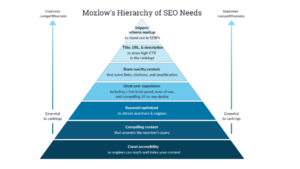By Christa Freer
Search engine optimization (SEO) is a phrase we hear constantly in digital marketing. Simply put, SEO is the process of improving a website’s content in order to increase the site’s organic, unpaid traffic. It is a way of manipulating search engine algorithms to make your site stand out and appear higher on search engine result pages (SERPs).
By utilizing SEO best practices, web owners can greatly increase their chances of appearing at the top of a results page for little to no cost. This will provide more people access to your business and, hopefully, expand your organic customer base in the long run.
According to an article from Moz, there are seven steps to achieving successful SEO. They’ve playfully been dubbed “Mozlow’s Hierarchy of SEO Needs” after the psychological study that prioritizes basic needs over more advanced ones.

What it takes to make it when it comes to SEO and marketing your business digitally.
Step 1: Crawl Accessibility
Search engines are equipped with “crawlers” that scan the internet for relevant content related to queries. The crawlers analyze your website to understand the content and how user-friendly it is.
“Crawlers look at web pages and follow links on those pages, much like you would if you were browsing content on the web,” Google explains. “They go from link to link and bring data about those webpages back to Google’s servers.”
An article from Lyfe Marketing says that search engines are designed to provide users with both the most relevant and highest quality content available online according to their search. This means that any dead ends or defective links on your site can negatively affect your SEO from the jump. Structural issues like that can unintentionally block crawlers from reaching your site, so it’s important to update your website regularly with premier content that is easy to navigate.
Crawl accessibility is at the base of Mozlow’s hierarchy because if a search engine is unable to evaluate your site, no amount of keywords or engaging content is going to help your site end up at the top of a SERP.
Step 2: Compelling Content
Having fresh, creative content on your website is crucial to attracting search engines and connecting with users. Your site will likely move up in the ranks on a SERP if you consistently post relevant and high-quality content. Visitors to your page are more likely to return if they find the content engaging or interesting.
The best way to attract both search engines and new users is to post a wide variety of types of content. Blog posts, articles, social media posts, how-to guides, infographics, and audio and video content are all examples of different kinds of content you can incorporate into your website in order to improve your SEO. Make sure each piece is well-written and covers a topic that is relevant to your desired audience.
Step 3: Keywords
One of the most important factors in SEO is keywords. Keywords are targeted words or phrases that best describe the content on your page or in that particular piece of content. You can think of it in terms like this: the words and phrases people are typing into a search engine are the keywords they will use to find your website. This is the main reason why choosing the correct keywords is so essential. If you get it wrong, you may never reach your target audience.
The experts at Yoast suggest making sure your keywords are evenly distributed throughout a piece. If you have too many at the very top of a post, it could actually affect your SEO negatively. Search engines are very smart and they can often tell when people are trying to manipulate SEO tactics. A good rule of thumb is to keep around one to two percent of the copy made up of keywords. Be sure to also incorporate keywords and phrases in your page headers and subheads for better traction with SERPs.
Step 4: User Experience
Just like any other business, user experience is the top priority when it comes to SEO. If people don’t like your website design, can’t navigate it easily, or don’t engage with your content then they more than likely won’t return to it or recommend it to others.
In order to make your site more appealing to customers and increase your overall user experience, make sure the website is easy to navigate, works well on mobile devices, and loads promptly. Your content should be easy to read, visually engaging, and contain links to related content whenever applicable.
The latest in user experience is something called “ambient computing.” This is the idea that as technology becomes more integrated into everyday life, we as users come to expect it.
“User experience becomes simply life experience: intelligent computing permeates daily activities,” reads one definition of ambient computing from Webopedia. “That integration means that users are constantly experiencing the business, even if they don’t think of it that way.”
Step 5: Share-Worthy Content
Compelling content and share-worthy content are not necessarily mutually exclusive. Share-worthy content finds itself closer to the top of Mozlow’s Hierarchy of SEO Needs because, in order for something to be shareable, it must first be interesting and exciting.
Content becomes share-worthy when it engages the reader in some way, such as providing them exclusive information or entertaining them. An article from AllBusiness stated that writing eye-catching headlines, being relatable, solving a problem, employing an emotional angle, mentioning others or linking related content, and capitalizing on trendy topics are all great ways to successfully increase the shareability of your content.
Step 6: Title, URL, and Description
While content is the most important part of a website, the superficial design is significant, too. The title of your site, the actual URL, and the description will all contribute to something called click-through rate (CTR) — the ratio of users who click on through to a page versus the total number of users who saw it on a SERP.
A high CTR means that organic traffic to your site is increasing, so your SEO will be positively affected. While appearing at the top of any SERP is obviously going to increase your CTR, so will having an attractive web design. The title of your website and its description are the first things potential customers will see and will be the hook to draw them in, so it’s important that they’re captivating and authentic to your brand.
Step 7: Rich Snippets and Schema Markup
The final step to achieving successful SEO is appearing on SERPs as rich snippets. A snippet is essentially just how a search result appears to users — title in blue, the URL in black, and a description of what the page is about. A rich snippet, however, includes much more information within that result, such as photos or text contained within the article being linked.
A rich snippet will lead to much more clicks than a standard one. To achieve rich snippets, you must employ something known as schema markup. Schema markup is a particular way of coding that helps search engines return more informative results for queries by defining content within the result.
Marketing guru Neil Pate explains schema markup as being something of a virtual business card.
“When a website has schema markup in place, users can see in the SERPs what a website is all about, where they are, what they do, how much stuff costs, plus plenty of other stuff,” Pate said. “Search engines exist for users to gain the information they need. Schema markup does exactly that.”
For more information about improving the SEO content on your business site, contact Wagner Freelancing at (806) 220-5272. The initial consultation is free and there is no obligation.

